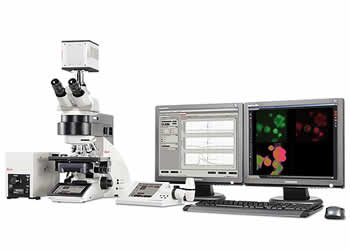Leica AF6500 Fluorescence Station
Leica Updated: 2009-02-07 RSS
Ultrafast 2D Time-lapse
The high-speed fluorescence system with all the functionality of the Leica AF6000 plus high-speed real-time control of a camera and a filter wheel as required for ultra-fast 2D time-lapse experiments and ratio imaging. Automated research microscopes, both upright and inverted, from Leica Microsystems are the ideal platforms for the Leica AF6500. Use the ratio imaging function to measure concentrations of second messenger substances such as Ca2+ at resolution over long periods of time. The system is also ideal for examinations of a wide variety of cellular processes such as exocytosis, transport processes within the cytoskeleton and membrane fusions. TTL trigger signals can be used to trigger peripherals like peristaltic pumps and injectors or start experiments by incoming TTL trigger pulses.
Key Features
* Real-time 2D time-lapse experiments
* Multi-dimensional 3D imaging
* High-speed ratio imaging
* Peripheral triggering
* High speed control of camera, one External Filter Wheel, shutter of Leica EL6000 external light source, 2 TTL trigger in and 1 TTL trigger out channel
* Compatible with upright microscopes Leica DM5000 B, DM5500 B, DM6000 B and inverted microscopes Leica DMI4000 B and DMI6000 B
Dynamic experimentation with the Live Data Mode
You never know what will happen during the course of a live cell experiment, but you know that you should be prepared for anything. You need full flexibility during your time lapse experiment to change parameters in an instant. The Leica Live Data Mode module allows you to interactively monitor, log and change system behaviour, in response to what's happening during your experiment, for truly dynamic imaging.
Make changes on the fly
The Live Data Mode provides three levels of direct user interaction. The first level allows you to directly modify the acquisition parameters during an active experiment. With a single click, new experimental setups are taken over and the image acquisition commences with the new parameters. This is crucial, for example, when time intervals, exposure times or light intensities have to be changed during a running experiment.
Respond to your changing experiment
The second level enables users to define jobs and activate them at any point during the course of the experiment. A typical example could be the addition of a DIC image to an experiment, at any time, without interrupting the flow of the active job. After acquiring the DIC image, the experiment proceeds with the former experimental setup. Consequently, a time lapse experiment can consist of hundreds of fluorescence image stacks but only a few single DIC images, as and when they are required to document specific points in the process.
Complexity with automation
The third level of interaction, allows you to combine different jobs into a macro for automated acquisition of an experiment with varying experimental conditions throughout. A single DIC image can be combined with a fluorescence z-stack acquisition. For highly sophisticated experiments, you may even combine several macros together. TTL trigger signals can be used to trigger peripherals like peristaltic pumps and injectors or start experiments by incoming TTL trigger pulses. The acquired images are displayed online. During acquisition regions of interest can be defined and intensity graphs displayed and monitored.
Leica external filter wheels
The Leica AF6500 allows the high-speed real-time control of one Leica external filter wheel and can easily be controlled within the LAS AF software interface. The filter wheels provide an extremely fast switching between different channels for live cell imaging. The applied Leica EL6000 external light source includes a high speed shutter with 6 ms switching time. Its 120 W long-life metal halogenide burner gives high intensity levels, especially in the blue light range.
Ratio Imaging
The ratio imaging tool generates ratios of user defined fluorescence channels. The ratio results are displayed online during acquisition in a ratio graph and in a statistics table. An online ratio image shows instantly changes in the ratio during acquisition. Regions of interests can be added or removed during acquisition. The results of all regions of interest are displayed in the online ratio graph. For Ca2+ quantification with Fura2 the Grynkiewicz formula is implemented.
The AF6500 in combination with the Leica external filter wheels allows real-time ratio imaging at high-speed.
Brochures
Data Sheet
Related Manuals
Leica AF6000 Advanced Fluorescence Imaging System
Leica AF7000 Dedicated Fluorescence Live Cell Station
Leica MM AF Integrated System
Leica AM TIRF MC Microscope
Leica DCM 3D Measuring Microscope
Leica DC160 Consumer Camera Kit
Leica DFC290 HD Digital FireWire Camera
Leica DFC295 Digital Camera
Leica DFC310 FX Digital Camera
Leica DFC340 FX Digital Camera
Leica DFC360 FX Monochrome Fluorescence Digital Camera
Leica DFC400 Digital Camera